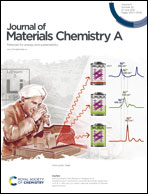Tracking the evolution of embryonic zeolites into hierarchical ZSM-5†
Abstract
The use of organosilanes as mesopore generating agents produces hierarchical zeolites with enhanced accessibility, outstanding catalytic properties and great potential for the development of nanocomposite materials. The current work investigates the changes undergone by the samples recovered from the synthesis gel of hierarchical ZSM-5 at different stages of the crystallization, covering for the first time in this strategy the whole range from X-ray amorphous embryonic zeolites to fully crystalline materials. Increase of the silica connectivity, reduction of the BET surface and appearance of zeolitic-like entities are observed in the early stages of the synthesis, which is accompanied by an enhancement of the interactions between the organic structure directing agent (OSDA) and the inorganic components. Likewise, the hydrothermal treatment induces important variations in the Al coordination and the acid properties. All these changes have a noticeable effect on the catalytic behaviour of the embryonic zeolites for LDPE cracking, showing increasing plastic conversion from 25 to 85%. The occurrence of different types of evolving zeolite embryos is envisaged, exhibiting hybrid configurations (combination of cage encapsulation and core/shell structures) that reconciliate earlier opposite models. Likewise, it is concluded that crystal growth proceeds through aggregative events (first random, then oriented) of nanounits, which are partially hindered by the grafted organosilane molecules, thus affording the generation of globular particles with hierarchical porosity.



 Please wait while we load your content...
Please wait while we load your content...